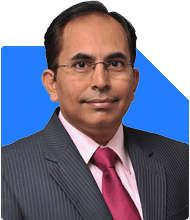Can I earn Rs 30,000 monthly returns on Rs 50 lakhs?
Janak Patel |71 Answers |Ask -Follow
MF, PF Expert - Answered on Mar 26, 2025
He is the CEO and founder of InfiniumWealth, a firm that specialises in designing goal-specific financial plans tailored to help clients achieve their life goals.
Janak holds an MBA degree in finance from the Welingkar Institute of Management Development and Research, Mumbai, and has over 15 years of experience in the field of personal finance. ... more

Hello Sir, I have saving 50 lakhs, i am looking for monthly return of 30 k What the best to possible way to invest this amount. Is it good option to invest in index fund . Please advice
You have not clarified the duration of your requirement, how long do you need monthly return?
But lets assume this is as long as possible.
There are many solutions to this and that involves knowing a lot more about you and your life state but will anyways will provide you a couple of options.
1. Fixed income investment - Invest in FD's at 7%, this will earn you 3.5 lakhs a year and should be covering your requirement. But the savings will remain at 50 lakhs. If the rate on FD falls down, then you will end up using your savings to cover your requirements. So this option may not be feasible for a long period. The risk being low, it may not grow your saving and it can erode your saving too.
2. Invest in Equity (mutual funds) - You mentioned Index funds, they can be considered along with other equity mutual funds too. But understand, there is a higher level of risk involved. Markets are and will be volatile and the returns will not be the same each year. If you have the temperament/patience to stay invested in market fluctuations then venture in this direction. When you are looking to fulfill your requirement each month, your investment will always stay on your mind and this will trigger behavioral traits and hence I mention temperament. Many people get unsettled seeing their investments erode in a short period of time and take decisions which are not rationale. Hence enter knowing the risk and yourself.
3. Middle ground - Invest in balanced option - something like a hybrid fund. If you are conservative (low risk), then go for conservative hybrid mutual fund schemes (more Debt and less equity) and expect returns slightly above your FD in the range of 8-9% which will serve your requirement and can add a bit to your savings. If you are not conservative and understand that market linked investment can provide a little extra boost to your investment then balance your risk with Balanced advantage Mutual Fund schemes (balanced approach to equity and debt). These schemes can provide you better returns up to double digits 10-12% and hence after meeting your requirements, your investment can grow too.
Please understand, Equity brings in market risks and hence have expectations but also understand the risks involved. Make your decision based on the appetite you have for loss bearing and safety and accordingly go ahead. Consult a good advisor or a financial planner who can guide you after knowing more about you and your requirement and also help understand tax implications.
Thanks and Regards
Janak Patel
Certified Financial Planner.
You may like to see similar questions and answers below
Ramalingam Kalirajan |10870 Answers |Ask -Follow
Mutual Funds, Financial Planning Expert - Answered on Apr 23, 2024
Ulhas Joshi |280 Answers |Ask -Follow
Mutual Fund Expert - Answered on Jun 07, 2024
Ramalingam Kalirajan |10870 Answers |Ask -Follow
Mutual Funds, Financial Planning Expert - Answered on Jan 20, 2025
Ramalingam Kalirajan |10870 Answers |Ask -Follow
Mutual Funds, Financial Planning Expert - Answered on Jul 30, 2025
Naveenn Kummar |233 Answers |Ask -Follow
Financial Planner, MF, Insurance Expert - Answered on Sep 11, 2025
Ulhas Joshi |280 Answers |Ask -Follow
Mutual Fund Expert - Answered on Dec 05, 2025
Dr Dipankar Dutta |1835 Answers |Ask -Follow
Tech Careers and Skill Development Expert - Answered on Dec 04, 2025
Ravi Mittal |676 Answers |Ask -Follow
Dating, Relationships Expert - Answered on Dec 04, 2025
Anu Krishna |1745 Answers |Ask -Follow
Relationships Expert, Mind Coach - Answered on Dec 04, 2025
Anu Krishna |1745 Answers |Ask -Follow
Relationships Expert, Mind Coach - Answered on Dec 04, 2025
Mayank Chandel |2562 Answers |Ask -Follow
IIT-JEE, NEET-UG, SAT, CLAT, CA, CS Exam Expert - Answered on Dec 04, 2025
Mayank Chandel |2562 Answers |Ask -Follow
IIT-JEE, NEET-UG, SAT, CLAT, CA, CS Exam Expert - Answered on Dec 04, 2025
Mayank Chandel |2562 Answers |Ask -Follow
IIT-JEE, NEET-UG, SAT, CLAT, CA, CS Exam Expert - Answered on Dec 04, 2025
Mayank Chandel |2562 Answers |Ask -Follow
IIT-JEE, NEET-UG, SAT, CLAT, CA, CS Exam Expert - Answered on Dec 04, 2025
Mayank Chandel |2562 Answers |Ask -Follow
IIT-JEE, NEET-UG, SAT, CLAT, CA, CS Exam Expert - Answered on Dec 04, 2025



























